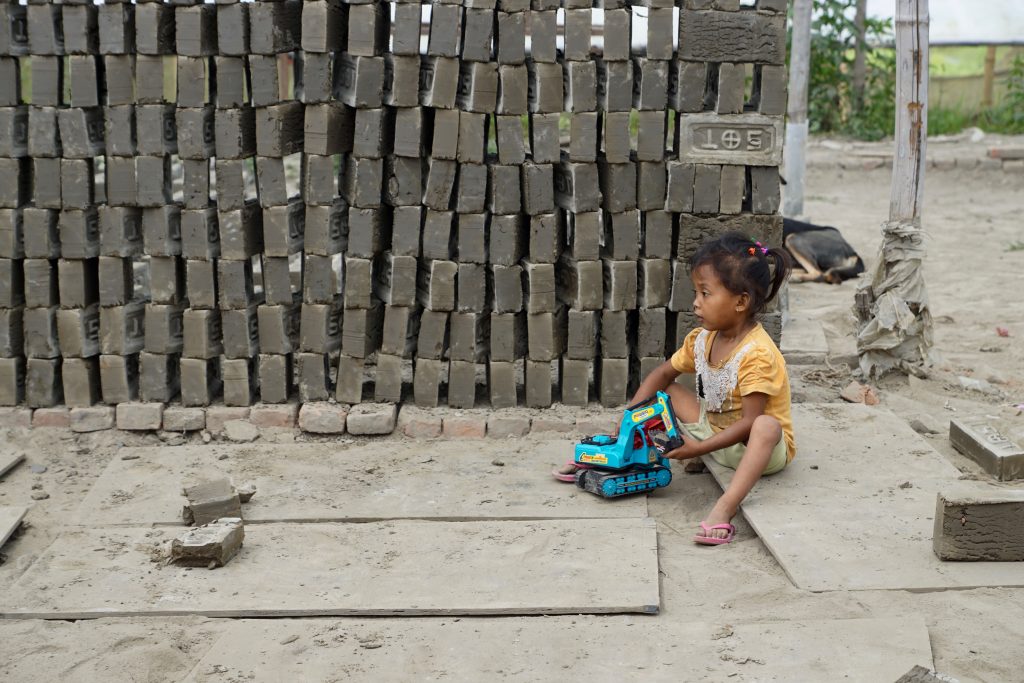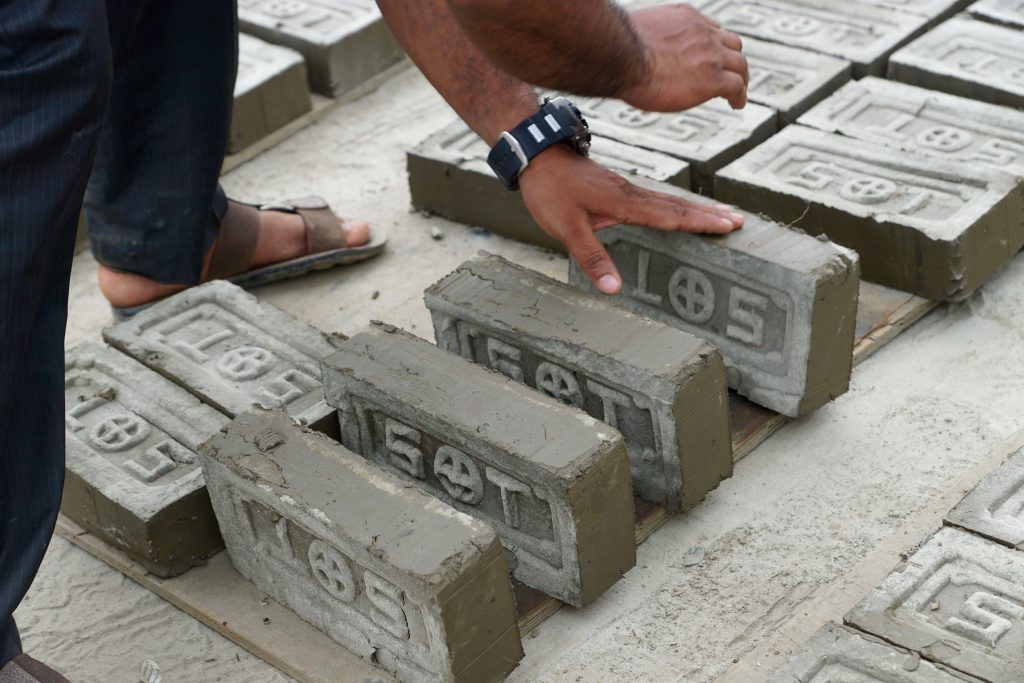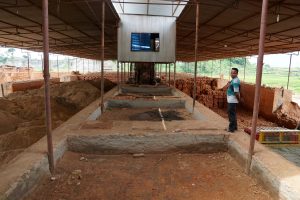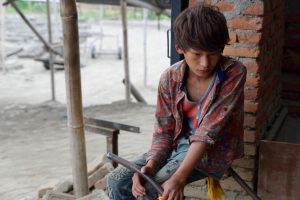
Children who live inside the brick factory where their parents are working are much more likely to start working when they are around 8 years of age. (Bhaktapur/Lara Cerosky)
Are you working in a brick factory during seasonal time?
Yes.
What are you doing?
I am flipping brick.
Only flipping bricks?
Yes, baba and mommy do not want me to do other things.
Why?
They say, I have to sleep at night to be good at school. I am only flipping bricks after school to help them, but they work alone at night.
Until are you up after school when you help your parents?
I stop working at 10pm.
And on Saturdays and public holidays?
On Saturdays I work until 7pm.
You start working directly after school, once you come home?
No, first I do my homework.
When did you start working in the brick factory?
Around 8 or 9.
When did you start flipping bricks?
When I was 6. My brother also started when he was 6.
Why are you saying that you only started working when you were around 8/9, if you started flipping bricks at age 6?
Because at that time I did not know how to make nice bricks. Before it was not really working, It was a training, I was learning. I can only do nice bricks since being 8 or 9.
So today you are only flipping bricks but not making bricks anymore?
Yes.

A naike is demonstrating how his 14-years old daughter is flipping bricks at night in the brick factory. (Bhaktapur/Lara Cerosky)
Mixing, making, flipping, piling
Alina is “only” flipping bricks because her parents eventually understood the necessity for, to have time to rest and play instead of working in the kilns without a break, regarding her personal development and her school level. Rama wakes up very early, because she has to work from 1 to 8 am before going to school, a time where she is making bricks in the dark, while after school from 4 to 7pm, she is also flipping and piling bricks and cleaning the factory. Roj was helping at night time before school, from 1 to 3 am, when all family members were mixing the mud – with the help of a small dozer because it needs to be done before sunrise – then he was sleeping and taking his meal before going to school. Back from school, Rojina is first cooking for her family, does her homework and then goes to work in the kilns for one hour, where she is collecting dried bricks and piles them, and also cleans the production areas within the factory. Balram tries to avoid carrying bricks because he considers it as being the most difficult task in the kilns, where he has to work about one or two hours in the morning and again one hour or more after 3pm.
While the nature of the task and the time allocated to work differs from one child to another, some common features can be noticed. In average, children usually start to work in the kilns at the age of 8. From the 18 children working in brick factories in 2018, all started between age 6 and 10, with a regular distribution between the ages they started working.
The tasks depend on the age of the children, usually the younger children start with flipping bricks and cleaning the brick production places. Later they also start to mix mud, to pile bricks and to carry them by hand. The older ones usually make bricks and carry them on their back, while still doing tasks previously enumerated. However, most of the children do their homework before starting their daily work in the kilns, be it before or after school. When homework plus household chores, such as cooking, cleaning the house or looking after younger siblings, are done, children usually start their daily work in the factory.

As long as a child lives within a brick factory he remains at high exposure to child labour. If one parent finds a job outside the brick factory, and accordingly the family moves out of the kilns, there is a high probability for the child to stop working in the brick factory. (Bhaktapur/Lara Cerosky)
Why bricks?
Parents who make the choice to work in brick factories, do so because without having any skills, it is the job that has the highest financial returns. Most of the parents are illiterate and find themselves in a poor economic situation with a financial high pressure to run properly the household, guarantee their children access to education, or pay back a loan. The more bricks are done by the end of the day; the more money is brought home. The additional income provided by children’s work enables the family to buy more food, pay school fees and education material of the household’s children, or simply to increase the family’s living condition. Some parents in the situation of reimbursing big amounts of money – whatever the reason leading to this issue – make their children work with them. However, some parents have more understanding for their children’s need for doing something else, outside school hours, instead of mixing mud, making bricks, flipping, piling or carrying bricks. When the loan to reimburse becomes less or has been totally reimbursed, parents find another job where they have to work less hard, and where earning less money is not a problem anymore.
When CONCERN started to support the children, the staff relied mostly on schools to target the parents whose children were working in brick factories. In some cases, parents were informed by the principals about a possible support by CONCERN, when they were about to pay school fees or during a parent-teacher meeting. Some schools like Dattatraya school, also visit brick factories once or twice a year to control if children are working there. In some cases, parents were informed about CONCERN’s sponsorship within the brick factory, when CONCERN staff along with teachers and the brick factory owner, gathered all the parents working in the factory to enrol their children.

Tasks are divided between gender. Piling bricks, so they can dry properly before being collected to get burned, is a task reserved to women and children. (Bhaktapur/Lara Cerosky)

The final step in the brick production process is the brick burning, which happens in a special place of the brick factory. The factory’s chimney radiates such a heat that thousands of bricks arranged around get burned. (Bhaktapur/Lara Cerosky)
Avoiding drop outs
The main reason behind the children’s dropout is their transfer from one school with which CONCERN has a partnership, to another school that is not supported by CONCERN. Children have to change the school for different reasons, but most of the time, they have to be transferred to another school because the school they are attending does not teaches classes for the new grade they passed to. As a consequence, children drop out because their parents can not afford the school fees of the new school their child has been transferred to. This situation happens because the partnership with schools is prioritised towards the support of the child throughout his education. Another main reason behind children’s dropout is the regular physical punishment violent teachers inflict on them when homework is not done or because of misbehaviour. This is a frequent issue in governmental schools where teachers resort to physical violence towards their pupils. As a consequence, children who have no time to do their homework, or who get no help at home to do their homework are more likely to be victims of violence at school. Accordingly, many children who face physical punishment at school are traumatised and quit school. If a child drops out because he is victim of physical punishment by his teachers resulting from homework that is not done, a tuition program seems to be a reasonable program to respond to both problematic situations. It can be a drastic change in their approach to school, if children are involved in the learning process without being constantly terrorised to go to school.
If the objective is to prevent drop outs and to stop making children work, a personal relationship has to be developed with the parents. If they are trusting the field assistant, they will be more easily inclined to speak about their difficulties, challenges they face, successes and thoughts. These discussions should occur at least once a month. On dropouts, if parents migrate, the field officer can more easily be informed and discuss the issue with parents, in meeting them regularly.

Children are more likely to drop out of school when they face physical punishment by professors, resulting from homework that has not been correctly done. Physical punishment is frequent in governmental schools. Children working in the kilns have often no time or get no help to do their homework. A tuition class after school to help children do their homework is an interesting approach to decrease the high rate of school dropouts. (Bhaktapur/Lara Cerosky)
Escaping the kilns
One fact is the same to all the children working in a brick factory: if they live within the factory, they almost have no chance to escape the labour work in the kilns. When at least one parent does not work in the brick factory anymore, the family moves out of the factory what is the main reason why children stop to work in the kilns. In such cases, parents work in a sector where they either earn more money, or if the new income is lower, it is because they have to work less hard. The adjunction of exercising another profession and moving out of the brick factory dramatically decreases the rate of working children.
Offering parents the opportunity to get a training in gardening, goat farming, vehicles repairing, sewing or else would certainly encourage them to find another job – consequently they move out of the brick factory – that should preferably make them earn enough money, to stop making their children to work. The total income from the new job exercised without their children’s help, should be higher than the salary they earn in the brick factory when their children are also working. It should also be considered to financially compensate the days of training for the loss it brings in the daily brick production. If parents get trained, it can be imagine to assist children in their working plan, when they are above 16 years of age and have a sufficient school level, but who show no interest in school anymore and express their interest for other professions. If the child clearly demonstrated his opposition to continue to go to school or to work in a brick factory, and if he has no or not enough skills for the job he wants to do, a sponsored skills training can be imagined for him, or a way to help him establish his own business.
Many children are still working before and/or after school, and during Saturdays and public holidays, even though they get supported by CONCERN and AP. Escaping the work in the kilns goes together with escaping the life in the kilns.

Many brick factories are located around the city of Bhaktapur in the Kathmandu Valley. (Bhaktapur/Lara Cerosky)

Nowadays, most of the brick factories have public sanitaries for all the workers living within the factory. However, during the high season, more than 1000 workers share three sanitaries and one water source out of the tab. (Bhaktapur/Lara Cerosky)
Even though, the 50 Children Program’s main goal was not a full success – given that many children are still working and that results showed that sponsoring the school education is not enough to help and persuade parents not to make their children work in the brick factory ever again – the 50 Children Program is neither a waste of time and money, nor a complete defeat, because the children supported are going to school everyday and through a full calendar year. Even though, most of them continue to work with their parents in the brick factories, they seem to be working a little less. Moreover, every year that has been sponsored by AP, helped children to get an improved education and a uniform, an inestimable gift for them. Those families that are supported since years by CONCERN show a commitment to their children’s education and understand the necessity to make them stop to work, even though it is difficult for most of them to really renounce on their children’s help. It shows that they are willing to do so, but need other incentives, therefore, redesigning the program seems to be a valid approach.
Posted By Lara Cerosky (Nepal)
Posted Nov 5th, 2018

